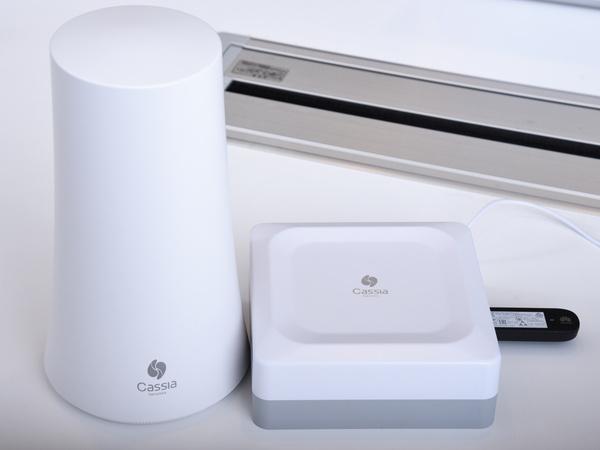ASCII.jp Ble IoT Device is eliminated and asks the Bluetooth router CEO
In June 2018, the Tokyo Electron Device (TED) started handling the Cassia Bluetooth router developed and manufactured by Cassia Networks in the United States.It is a product that can communicate between up to 40 Bluetooth Low-Energy (BLE) devices per unit and a maximum of 300 meters.You can also install multiple routers and centrally manage all BLE devices in the area.
Overseas, it has already begun to be used at factories, school campuses, hospital / nursing care facilities, etc., which introduce thousands of BLE IoT sensors / beacons.This time, Felix Zuo of Casia Networks CEO came to Japan, and asked the Cassia Bluetooth router / controller / controller's characteristics, techniques, introduction cases, and the development of edge computing.
Felix Zhao, founder and CEO founder and CEO.He was studying sensor network at Cisco Systems until 15 years ago
The main unit of "Cassia Bluetooth router"."X1000" (left), which is waterproof and dustproof that can be installed outdoors, and indoor "E1000" (in the photo, the USB LTE modem is attached to the E1000).
"I want to change the prejudice" of the BLE device of short distance / 1 -to -one connection
Kasia Networks was a venture founded four years ago in Sir Convalley in 2014.Currently, it has a development subsidiary in China and already sell Bluetooth routers in North America / Europe / China market.He won the "Best of CES" in the Connected Home category at CES (Consumer Electronics Show) in 2016, and the 2017 CES.And this time, it will be expanded in the Japanese market through TED.
Cassia's Bluetooth solution makes it easier to introduce IoT and enables innovative application development
The Cassia Bluetooth router is a device that connects up to 40 BLE devices as described above to route wireless LAN (Wi-Fi), wired LAN, and 3G/LTE lines.The lineup of "X1000" for outdoor installation corresponding to PoE power supply and "E1000" for indoor installation."Up to 40" is a maximum value for two -way communication, and if you only receive data from the BLE sensor / beacon (one -way communication), you can connect 100 or more.
Another feature is that it enables BLE devices and up to 300 meters long -distance communication.This covers large areas such as factories, hospital facilities, and campus so that communication with moving devices such as wearable terminals can be easily communicated.

"Bluetooth is a very IoT communication standard, but there are many restrictions," for the reason he founded Cassia and worked on the Bluetooth router.Bluetooth consumes much less than Wi-Fi and is much more popular than Zigbee."Last year's device shipments were about 2 billion in Wi-Fi, 3 million ZIGBEE, and 4 billion Bluetooth," said Zao.
However, looking at the familiar BLE devices, for example, it is assumed that "at a few meters" and "connect to a PC / smart device on a one -on -one", such as wireless mouse / keyboard, speakers, and smartwatches.It's just something.Mr. Zao, who has studied sensor network, wanted to change it here.
"The current Bluetooth is a prejudice of" the last 1 -meter "is captured with a prejudice such as" I can't remotely operate the device. "I developed a Cassia Bluetooth router, hoping to make it possible to use it. "
Bluetooth/BLE has features suitable for IoT, such as power saving, low cost, and open, but also has issues such as short communication distance and one -on -one pairing.
By the way, general BLE devices support only about 10 meters of communication distance, but the Cassia Bluetooth router enables long -distance communication without changing the BLE device side at all.When asked what kind of technology made it possible, Zao replied that there were three points: "smart antenna of its own technology", "router sensitivity", and "interference noise level reduction."The housing of the product is about the same size as a wireless LAN access point for corporations, but most of the large internal antennas are occupied.
Supports controllers for large -scale IoT environments, edge computing
Another management console "Cassia IoT Access Controller" is also available as a product for large -scale environments that install multiple routers.Through this software, more than 100 routers and thousands of BLE devices can be centrally managed and controlled, and the communication environment, such as device roming and road balancing between routers, is also controlled.It is also possible to use the SDK provided to connect API to this controller and develop an application that uses that data.
Web interface (dashboard) of "Cassia IoT Access Controller".The server can be placed on both on -premises and on the cloud
By introducing an access controller, for example, you will be able to do a batch update of the firmware, and also work together to pair new devices and register new users.
If you have three or more routers, you can get the location information of the BLE device in real time in the so -called triangular surveying method (error 5 to 10 meters).If you register a map in the access controller in advance, the administrator will be able to check the location of each device on the map.For example, it can be used for checking the location of site workers in the factory and managing assets at hospitals.
In addition to collecting data from devices, you can also get the location information of the device.
In addition, Tsuo explained that the Cassia Bluetooth router and access controllers also "support edge computing."Since both products have a mechanism that allows the third -party apps to be installed on the routers and controllers, data processing and device control can be performed on the edge (site).In fact, the smart building solution sold by the United States Zan Compute says that apps installed on the Cassia Bluetooth router process sensor data and transfer only important data, such as failure, to the cloud.